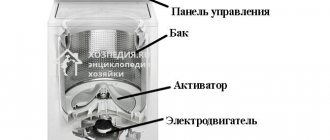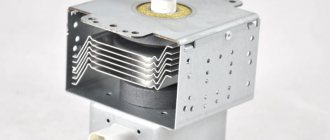What is an inverter microwave oven, how is it different from a regular one? Is it worth overpaying for the benefits promised by consultants? To get to the bottom of the truth, let's understand their structure and find out how a microwave oven with an inverter differs from a simple microwave oven.
Manufacturers claim that such models are much better. Is it true that food cooked in them turns out tastier, more beautiful and retains more nutrients?
Why do you need an inverter?
Even those who do not know physics well understand that in a microwave oven food becomes hot and edible under the influence of ultrahigh frequencies - microwaves. Molecules set in motion by an electromagnetic field release thermal energy. Since the waves are able to penetrate objects through and through, the food in the chamber is evenly heated, not only on the surface, but also inside.
Where do the waves come from in a microwave oven? They are emitted by the magnetron - the “heart” of the device, its main part. In conventional furnaces, the magnetron is powered through a transformer, in these furnaces - from an inverter. This is a control unit and a DC-AC converter. It is in this block that the difference between conventional and inverter systems lies.
Since the inverting element is much smaller than the transformer, there is an advantageous difference in size and weight.
Saving electricity
At first, the statement that an inverter microwave oven saves energy seems a little strange - after all, it works constantly, while a non-inverter microwave oven works intermittently. Let's explain: although the inverter works constantly, as a rule, it gradually reduces the power of the microwaves (and therefore the amount of electricity consumed). In addition, the magnetron is turned on only once - at the start of the cooking process. In a non-inverter furnace, the magnetron operates intermittently, but always at the maximum (installed) power - this results in more electricity being wasted. Constant switching on also adds waste - at these moments the oven consumes the maximum possible electricity.
Operating principle of inverter microwave ovens
The magnetron, generating microwaves, gradually reduces the radiation power. The effect on the molecules becomes softer, which prevents them from overheating.
In conventional stoves, the magnetron does not reduce power, but only shortens the intervals of wave impacts and increases the pauses between them. This is more “traumatic” for the molecules; moisture is lost and the product dries out. In an inverter, due to a gradual decrease in radiation, it is possible to preserve the structure of the molecules. What is the practical interest in this for the consumer? Products retain their shape better, they are more attractive on the outside and healthier on the inside.
The essence of technology
An innovative method of cooking food is proposed - Inverter Combination Cooking. This technique eliminates the disadvantages associated with traditional devices. Microwave ovens cook quickly, but only inverter control makes it possible to brown food. By combining a grill or other functions with an inversion system, you can quickly heat and cook food that is healthy and looks delicious.
Accelerated defrosting
Consumers looking at microwave ovens with an inverting element are wondering what Turbo defrosting means. This is a technology that uses the principle of sequentially varying power. Thanks to Turbo mode, food defrosts twice as fast. The “chaos theory” is used, in which it is possible to distribute the energy of microwaves, alternating in the best way the principles of regularity and irregularity.
External differences
If you compare the external data, a device with adjustable power is no different from a regular one, except that it weighs less. All the differences lie in the principle of operation of the device. Thanks to the absence of a bulky transformer, the developers were able to reduce weight and increase the volume of the camera while maintaining external dimensions.
Electricity consumption
A huge advantage of the system is the economical consumption of electricity. The magnetron, which turns on only once per cycle, gradually reduces power, consuming 28% less energy. If standby mode is turned on, savings reach 72%.
Advantages and disadvantages
Like any technology, a microwave oven with an inverting element has its pros and cons. Advantages:
- Compact: spacious chamber, light weight.
- Uniform heating. The control system allows you to smoothly reduce the impact during the cooking process.
- Large set of functions. Dishes are prepared quickly and at the same time remain healthy. By combining microwaves with a grill, you can cook food with a crispy crust, just like in the oven. Microwave radiation can also be combined with steam and other options.
- Fast defrosting. A number of models have this function and defrost food twice as quickly. Since the intensity of the magnetron changes, defrosting occurs in a soft mode - beneficial substances are not destroyed, freshness is better preserved.
- No turntable. The absence of a plate gives more options for placing the container; one thing is important - that it fits in the chamber.
Experts and users find only one drawback with the stoves in question - the price. They are more expensive than regular microwaves. There are also a limited number of modifications.
Experimental testing
The advantages of inverter microwave ovens also include their operating scheme - the scheme for supplying microwaves to the working chamber. The fact is that in a conventional non-inverter furnace, the magnetron always operates with the same power and always discretely. This can be compared to a frying pan or saucepan on a gas burner. In the “inverter” mode, you can adjust the flame power of the burner - at first maximum power, after a certain time medium, at the end of cooking minimum. In the “non-inverter” mode, the burner is first turned on at the full set power, and then turned off completely. And so on throughout the entire preparation process. Only at different time intervals (towards the end of cooking the operating time of the magnetron decreases) - the magnetron constantly “hits” the product with all its possible power. This makes the structure of the finished product (it will, of course, also be cooked - not go anywhere) look somewhat more damaged, and the product may dry out (depending on the type).
In inverter microwave ovens, the magnetron operates continuously, and the microwave power usually decreases gradually throughout the cooking time. In non-inverter furnaces, the magnetron is turned on and off, always working with constant power
In the process of preparing this material, we tested both this (the operating principle of the magnetron) and the other (the quality of the finished products) experimentally. To demonstrate the continuous operation of the magnetron in an inverter furnace and discrete operation in a non-inverter furnace, we used a special “LED dish”. If microwaves enter the working chamber, the LEDs work; if they do not, they go out.
During the experiment, we were convinced of the “constancy” of the inverter furnace - the magnetron worked without pauses, the LEDs did not go out the entire time the furnace was working. In a non-inverter oven, the LEDs lit up, went out, and lit up again, illustrating the discrete mode of operation of the magnetron
Next was the preparation of various products and dishes. We cooked simple dishes in an inverter microwave oven
Panasonic NN-GD392S
and in a non-inverter oven
Panasonic NN-GT352W
— these models were provided by the manufacturer. Note that the maximum microwave power (only this mode was used) of the NN-GD392S oven is 950 W, and the NN-GT352W oven is 800 W. Therefore, in the process of preparing different dishes, in order to create identical cooking conditions in terms of power, the manufacturer’s specialists visually set on the control panel a slightly different power for both ovens. For the NN-GD392S model - “medium low” (360 W), for the NN-GT352W - “medium” (also 360 W). That is, the actual operating power was ultimately the same. With the same cooking time.
The first was milk. The same number. At the same power. Same time. What will happen to the milk? Will it completely boil over in a non-inverter oven? What does the manufacturer want to demonstrate? But let’s not get ahead of ourselves: same power, same time (4 minutes), simultaneous launch, milk. As a result, after 4 minutes, almost half of the already boiled milk poured out of the “non-vertron” glass onto the turntable. A little milk also spilled out of the “inverter”, but the amount of liquid that ended up on the turntable was much less.
Milk “doubly tastes better” when heated in an inverter oven. Seriously though, after heating in an inverter oven (on the right) there is definitely more milk left in the glass than after heating in a non-inverter oven (on the left)
Next are apples baked with sugar. Identical apples. Same amount of sugar. Time - 6 minutes. The power is still the same - “medium low” for an inverter stove and “medium” for a “regular” stove. In the end, we got results that at first glance were not as clearly different from each other as in the experiment with milk.
What should we do with them? Cook in inverter and non-inverter microwave ovens, of course
Both apples remained intact, juice mixed with melted sugar flowed out of both. But the apple from the non-inverter oven clearly changed its shape - it seemed to tilt to the right (initially, this “tilt” was not noticeable in the photo), which indicates a rougher effect of microwaves on the structure of the product. This apple was more "boiled" inside. At the same time, both fruits were ready. But the structure of the “invertronic” apple was less damaged. In general, there doesn’t seem to be a global bone of contention. But the differences are still noticeable.
“Apple” result. On the left is an apple from a non-inverter oven. Cooked, but slightly changed shape. On the right is the “inverter” apple. It's ready, the shape hasn't changed
After apples came “fishy times.” First, we cooked two identical (weighing 88 g) pieces of white fish in inverter and non-inverter ovens. The fish cooks quickly, so after two and a half minutes it was removed from the ovens. Again, a situation where at first glance there are no differences. However, if you look closely, the “non-inverted” fish has a noticeable yellowish crust in some places (let’s call it that) - these are the areas that dried out the most during the cooking process. Almost no yellowness formed on the “inverter” piece. In the end, the fish from the non-inverter oven actually tasted drier.
The fish in the non-inverter oven (left) actually turned out drier than the fish in the inverter oven (right)
The next fish (since it’s “fishy times”) is salmon steaks. Once again history repeats itself: the same weight (288 g), the same time (6 minutes). Only here we change the power settings a little: we set the average level for the inverter oven (600 W) and “medium-high” (600 W) for the non-inverter oven (remember, ovens have different maximum power - that’s why the power settings during the cooking process are slightly different, although the real The power level is ultimately the same.)
During the experiment, we adjusted the power of microwave ovens so that its actual performance was approximately equal. Due to the fact that the inverter model has a higher maximum power, the settings were visually different
After 6 minutes, we take out two ready-made steaks that look identical in appearance. This was the only case during our experiment when, in general, the prepared food had no noticeable external differences. The only thing is that the “non-inverter” steak was a little, let’s say, “unraveled” - slightly lost its shape. As for the taste, it cannot be said that after cooking in a non-inverter oven, the fish was, for example, drier (except that the skin dried out a little more). In this “salmon” segment of the test, it turned out to be a draw.
The salmon was generally successful in both ovens. Unless the “non-inverter” steak has spread a little
After the fish, it was time for the omelette. It was prepared at the same real power for 10 minutes. As a result, it turned out that the omelet in the inverter oven was denser and, in general, completely cooked. Whereas in a non-inverter oven, liquid “lakes” were clearly visible in the middle part of the omelette, indicating that the dish was not fully prepared. In addition, the edges of the “non-inverted” omelette were clearly more dry.
The omelette turned out to be of clearly better quality in the inverter microwave oven (right)
That's not all. It was decided to put the final point by preparing the liver. Anyone who has ever cooked (or heated) chicken liver in a microwave oven knows what this entails. But let's not get ahead of ourselves. We take the same amount of liver, cover it with a special lid for cooking in a microwave oven, set the time (4 minutes) and really the same cooking power (for an omelet, we again change the settings to “medium low” power for an inverter oven and “medium” for a non-inverter oven). Start.
Final chord. Equal amount of chicken liver. Which oven will handle cooking this popular product better?
After 4 minutes, we see in a non-inverter oven the obvious consequences of a “nuclear explosion” - the liver scattered all over the plate, all over the turntable, if there was no lid, the entire working chamber of the oven would have been dirty (and the lid itself was so dirty). In an inverter oven, everything is much calmer - a clean turntable and only a small amount of “scraps” on the plate, only a slightly dirty lid. There is clearly an advantage of smooth constant exposure to microwaves and power varying during the cooking process over periodic switching on at full blast.
The result, as they say, is visible to the naked eye. In the “battle for chicken liver,” a non-inverter microwave oven (the liver cooked in it is on the plate on the right) suffers a crushing defeat
It seems that after reading about all the above “adventures of products” in inverter and non-inverter ovens, it will not be difficult to draw certain conclusions about which oven cooks food better. The final point of this segment of the material is real photographs of the structure of food products under a microscope, taken during testing of inverter microwave ovens by the National Food Research Institute (NFRI).
The structure of food cooked in an inverter microwave oven is less damaged. More moisture is retained in the products: as a rule, it does not boil away during the cooking process, since the degree of exposure of the products to microwaves is gentle, and as a result, the structure of the product changes less
How much healthier is food from an inverter microwave oven?
The question of the healthfulness of microwave meals has always worried consumers. How true are the claims about the benefits of food cooked in a new type of oven? Any processing negatively affects the usefulness of the products. It is clear that due to the traumatic effects of electromagnetic waves, food loses its original concentration of nutrients - vitamins, minerals, and other nutrients are destroyed.
After repeated experiments and research, experts were able to state that ovens with an inverter operating principle can preserve the content of vitamins and minerals by about 30% more than conventional microwave ovens.
National Food Research Institute Research
NFRI research has produced real images of food structure under microscopic magnification.
It is clearly seen that products processed using the inverter method are less damaged and more moisture remains in them.
Also during the testing, the vitamin composition of the processed products was examined - and indeed, the food that was processed sparingly retained more useful components. So, in pork there was 42% more vitamin B1, and in cabbage there was 31% more vitamin C and 16% more calcium.
And finally, research in the field of energy saving has shown that the inverter significantly saves electricity, since the magnetron starts only when the program starts (based on testing Panasonic products).
How to choose
The selection criteria are practically no different from the factors taken into account when purchasing a traditional inverter-free model. Need to evaluate:
- dimensions;
- power;
- capacity;
- control;
- functional;
- price.
You also need to consider the expected intensity of use. To heat up ready-made dishes, 0.6 kW is enough - you can buy a solo stove. With additional functions, the power reaches 1.5 kW.
The capacity of the chamber is 14-20 liters. Large volume is recommended for families of 4-5 people. Capacious microwaves are also useful for partygoers who cook for guests.
When choosing a suitable modification, you also need to pay attention to:
- Control. Typically, models with a large range of options use a touch or electronic option - it’s faster, more accurate and more efficient to configure.
- Protection. If there are kids in the family, take a model with a child lock feature.
- Grill. Its functions can be performed by a heating element or a quartz lamp. In the latter case, the dishes seemed to be cooked over a fire. Some models have a vertical or double grill.
- Internal coating. The best option is ceramics or bioceramics. This is an easy to clean material that does not form carbon deposits. Has high resistance to heat and mechanical stress.
Summary ZOOM.CNews
By and large, there is only one downside to inverter microwave ovens - a slightly higher cost compared to non-inverter ones. However, recently the price difference has narrowed. A few years ago it could reach up to 50% and even be higher (depending on the model). Now, for example, the difference between the cost of the models participating in the experiment is only about 1 thousand rubles (the inverter Panasonic NN-GD392S will cost about 5.5 thousand rubles*, and the non-inverter NN-GT352W will cost about 4.5 thousand rubles) .
For the rest, we agree with the famous chef Alexander Seleznev - you shouldn’t expect incredible culinary miracles from an inverter oven. But she experimentally proved that she cooks, let’s say, smarter - the products and dishes are “smarter” because of this, as we have seen, they are prepared, basically, of higher quality. At the same time, you don’t need to spend any special effort for this (that is, prepare them in any special way - we didn’t prepare them very much during the test). Much less chance of drying out. Less chance of product losing shape. Plus, vitamins are better preserved from the partially gentle, essentially microwave treatment. Add to this the space saving in the kitchen. Energy savings.
We thank Panasonic for their assistance in preparing the material.
RUB 8,790
30% RUB 12,499
Microwave oven solo LG MS2595GIH
Pallet diameter 292 mm. Management is electronic. With automatic cooking. The inner coating of the camera is enamel. Maximum microwave power 1000 W. . With display. With automatic heating. With defrost mode. White color. Opening the door is a handle. With uniform microwave distribution system. Volume 25 l. With camera light. With audible shutdown signal. With automatic defrosting. Dimensions 27x48x37 cm.
Who is the manufacturer
The most famous manufacturer of the microwave ovens reviewed is Panasonic.
Panasonic NN-DS596
The described technology is used in the NN-DS596 model, which supports combined mode. Chamber volume - 27 l. Without turntable. There is a powerful steam generator and an upper grill.
Panasonic NN-CD565B
A compact model with a power of 1 kW, not inferior in functionality to full-size versions. Dimensions are reduced due to the special placement of the fan. There is a quartz grill.
Panasonic NN-SD 366 M
Silver-colored stove with a capacity of 22 liters and a power of 0.8 kW. Electronic control. Rotating tray with a diameter of 24.5 cm. Dimensions: 28x48x36 cm.
What Siemens offers
Panasonic is not the only manufacturer of these microwaves; Siemens also produces them. Among the models from this manufacturer, it is worth noting the HF 25M2L2.
Its capacity is 21 liters. The chamber coating is stainless steel. There is defrosting and auto-cooking. Push-button control.
Microwave from Whirlpool
The large AMW 848 IX microwave oven has the most spacious chamber ever: 40 liters. A whole Christmas goose will fit here. The oven has all the functions that a housewife dreams of - grill and convection. Suitable for roasting meat and preparing baked goods. Touch control. There is defrosting and auto-cooking.
Although inverter stoves are produced by a limited number of manufacturers, buyers have plenty to choose from. This technique will be a reliable help in culinary delights.
Basics
To begin with, it is logical to give a few fundamental definitions. So, a microwave oven is an electrical appliance for preparing food that uses the effect of heating materials (products) containing water by exposing them to electromagnetic waves in the decimeter range (most often with a frequency of 2450 MHz). Food molecules, liquids, contain negative and positive particles. In the absence of an electromagnetic field, the molecules are oriented in a random order. When cooking, under the influence of an alternating field, the molecules begin to rotate. The friction between molecules creates heat, which cooks food and causes water to boil. Heating of products here, in a microwave oven (it is also called a microwave oven; microwave is ultra-high frequency radiation, in this context - the same as microwave radiation), occurs not only from the surface (from above), but also through the volume of the product containing polar molecules of liquid (water). Radio waves penetrate the product to a depth of about 2-3 cm and are absorbed by it. We especially note that in a microwave oven there is no “heating from the inside” - such a statement can often be heard. No, microwaves come from the outside in. The effect of “internal heating” can occur when products with dry, non-moisture-conducting surfaces are processed in a microwave oven. For example, baked goods with a dried out crust. In them, most of the moisture is concentrated inside. Therefore, heating manifests itself deeper—hence the idea of “heating from the inside.” In everyday life, microwave ovens are used for quickly preparing various dishes, and also often for quickly defrosting or heating food.
In a classic microwave oven, some of the microwaves are reflected from the walls of the working chamber, then hit the food; the turntable helps to distribute the microwaves evenly.
A magnetron is an essential element of a microwave oven. It is he who generates electromagnetic radiation, with the help of which food is prepared. The transformer (also part of the furnace structure) provides high-voltage power to the magnetron. Microwaves are fed into the working chamber passing through a waveguide (special channel), which ends in the working chamber with an outlet channel (hole) transparent to radio frequencies. You should not turn on the microwave oven empty, because then the waves will not be absorbed by the product, but will be reflected from the walls of the working chamber, which can ultimately cause sparking. Long-term sparking can damage the magnetron (so if a small amount of food is being cooked in the microwave, it is advisable to put another glass of water in the chamber to absorb microwaves). There are microwave ovens with several waveguides - for a more uniform distribution of microwaves throughout the working chamber. There are also models in which the magnetron is installed at the bottom of the furnace (and not on the side, as in the vast majority of models). In this case, again for better distribution of radiation throughout the oven chamber, the microwave distributor rotates, which can be located in the working chamber from below or above.
There are microwave ovens without a turntable. The microwave distributor rotates in them. It can be at the top or bottom of the oven.
Finally, the inverter microwave oven is the main character of this material. The main difference between an inverter microwave oven and a “regular” one is the presence of an electronic control unit for the power of the magnetron (actually, an inverter - a device for converting direct electric current into alternating current). And the lack of a transformer. We will consider details about inverter power control of a microwave oven below. The fact that there is no transformer in the oven allows us to highlight some of this lack of advantages. Firstly, the electronic control unit takes up much less space - because of this, if we compare ovens with the same volume of the working chamber, the dimensions of a non-inverter oven will be slightly larger.
The transformer takes up much more space in the microwave oven and weighs more than the electronic inverter control unit.
Inverter (left) and non-inverter (right) stoves participating in the test (models below). They have the same volume of working chambers (23 l). The inverter one is smaller in size (one cannot say that the difference is global, but it is noticeable). In addition, an inverter oven weighs 3 kg less than a non-inverter oven (10 kg versus 13 kg).
Reviews
Panasonic NN-DS596: Oleg I., Sochi
I was interested in a new approach to cooking. I am satisfied with the purchase. The oven has all the main functions - microwaves, steam, grill, convection and plus combinations thereof. There are many advantages. Very quiet operation - you can barely hear the fan. There is self-cleaning. Food cooks much faster. There are no shortcomings, except for fingerprints that remain on the super glossy surface of the control panel.
Siemens HF25G5L2: Valentina T., Stary Oskol
I spent a long time choosing a microwave, I wanted to find the perfect one. I like that there are a bunch of automatic programs: I set a task, and I’m free - the stove will prepare everything itself. Great power - food cooks quickly. The food tastes good, you can't tell it was cooked in a microwave. I can put my favorite recipes into memory. Beautiful design, has a powerful grill - it comes out just like in the oven, with a crispy crust. Defrosts very quickly.
Using a new approach to power management, inverter microwaves produce tastier and healthier food. The equipment itself loses weight and size - these models are lighter, more compact and more spacious. The only negative is the higher price. But the benefits you get from the purchase are worth it.
Microwave oven and microwave ovens with inverter - what is the difference
Let's look at the main distinctive characteristics of inverter and conventional microwave ovens presented in the table.
|
| 40000 |
| MB63R35GIH from LG | Microwave oven, equipped with a number of programs: inverter, grill, 14 auto-cooking programs, 4 auto-defrost modes, child protection. | |
| The power cord is too short. | 10000 |
| MW-23R35GIB from LG | The microwave is equipped with an inverter, 4 defrosting modes, 22 auto-cooking programs, and child protection. | |
|
| 10600 |
| IMCG 25 from Caso | The device has the following functions: inverter, grill, convection, auto-defrost, 14 auto-cooking programs. | |
| There is no direct access to the control panel. The panel is located under the glass of the door - to get to it you need to open the door. | 23000 |
| Indicators | Regular microwave | Inverter microwave |
| Magnetron (wave generator) control | Transformer | Inverter |
| Magnetron operating principle | Power regulation by turning the magnetron on and off. | Multi-level control by smoothly reducing power from high to lower levels. |
| Dimensions | Because of the transformer, a classic microwave oven has an impressive weight and a relatively small internal chamber. | Due to the compact inverter in the microwave, the size of the internal chamber is much larger and the weight of the device is less. |
| Impact on products | Aggressive impact on food by a maximum level wave flow with periodic breaks. | Gentle on food through rapid heating and gradual reduction to a minimum. |
| Preservation of nutrients in products | 40-60% | 70-80% |
| Price | 3500-9000 rub. | 10000-43000 rub. |











